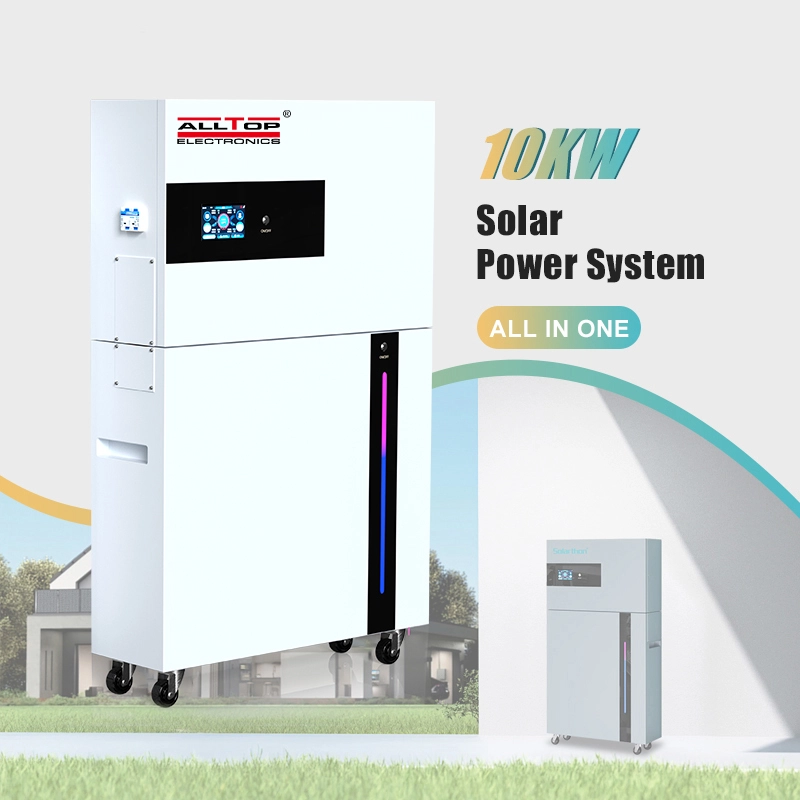All-In-One 10kW Hybrid Solar Inverter Lithium Battery for Home Energy Storage System Stackable
|
Item No. |
DQ1906E10K-02 |
|
Rated Power |
10kW |
|
Lithium Battery |
280Ah/51.2V |
|
AC Output Voltage |
230VAC |
|
AC Output Frequency |
50/60Hz |
|
AC Input Voltage Range |
230VAC |
|
AC Input Frequency |
50/60Hz |
|
Maximum PV Voltage |
500VDC |
|
MPPT Voltage Range |
90-450VDC |
|
PV Charge Current |
150A |
|
Maximum Input Current |
27A*2 |
|
Temperature For Operation |
-10-+50℃ |
|
Temperature For Storage |
-15 -+60℃ |
|
External Dimensions |
666*1157*220mm |
|
Max. Number Of Parallel |
6 sets |
|
Warranty |
3 years |
The Energy Storage Controller Inverter Integrated Machine combines the functions of inverter, MPPT solar controller and utility charging to provide
stable power supply for power-using equipment in areas with no power, lack of power and unstable power. The product is based on a fully digital
intelligent design with advanced SPWM technology,outputting pure sine wave, converting DC power into AC power, suitable for AC loads such
as household appliances, power tools, industrial equipment, electronic video and audio. LCD screen display design, real-time display of system
operation data and operating status. Comprehensive electronic protection function ensures the whole system is safer and more stable.
FUNCTIONAL FEATURES
● Pure sine wave inverters;
● Integrated MPPT controller/charger;
● Settable priority of utility and PV power supply;
● Wide PV input voltage;
● Settable battery type, supporting lead-acid and lithium batteries;
● Functions and parameters can be set via the LCD;
● With battery equalization function to optimize battery performance and extend
battery life.
SYSTEM SCHEMATIC
The following figure shows the system application scenario of this product. A complete system includes the following parts:
1. Photovoltaic module: Convert light energy into DC electric energy, charge the
battery through energy storage inverter, or directly reverse it into AC to power
the load.
2. Utility or generator: Connected at the AC input, it can supply power to the load
and charge the battery at the same time. If no utility or generator is connected,
the system can also operate normally, when the load power is provided by the
battery and PV module.
3. Battery: The role of the battery is to ensure the normal use of power for the
system load when the solar energy is insufficient and there is no utility power.
4. Household load: It can access various household and office loads, including
refrigerators, lamps, TV sets, fans, air conditioners and other AC loads.
5. Energy Storage Controller Inverter Integrated Machine: The energy conversion device
of the whole system.
Feature highlights:The ALLTOP Energy All in One 10Kw Hybrid Inverter and LiFePO4 Battery is designed for high performance and reliability, featuring a long life cycle of ≥6000 times at 80% DOD, maintenance-free operation, and a high-end BMS control system. It supports parallel connections, standardization in size, capacity, voltage, and current, and meets global certifications like UL, TUV, CE, and RoHS, ensuring compliance with international safety standards and providing market access. Equipped with REPT high-quality battery cells, it ensures stable and efficient energy storage for various applications.
Supplier highlights:This merchant is both a manufacturer and trader with capabilities in project design and quality control, offering full customization and design customization.
Match installation screw
We use K=K strong white carton outer package
Printing the product pictures on the boxes

